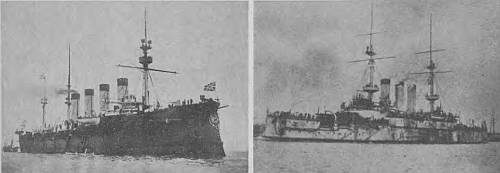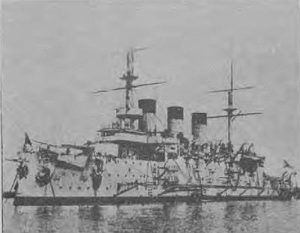- Author
- Swan, W.M., Lietutenant Commander, RAN
- Subjects
- Naval Intelligence
- Tags
-
- RAN Ships
- None noted.
- Publication
- December 1974 edition of the Naval Historical Review (all rights reserved)
In this second instalment on Japanese intelligence, Lieutenant-Commander Swan covers the Russo-Japanese War of 1904-1905 and the consequent penetration of China, Manchuria, Burma, India, Annam, the Philippines and Mongolia by Japanese agents. It was in this period the foundations were laid for the extensive intelligence network which covered Asia, America, the Pacific and, to a lesser extent, Europe in the pre-war years of World War II.

Armoured cruiser Rossia.
I.J.N. Shikishima
THE HOST OF JAPANESE AGENTS that spread over Asia in the years leading up to the Russo/Japanese War of 1904-5 were all well trained, a training period being about 18 months. The Black Ocean Society’s Intelligence School was at Sappiro, in Hokkaido. Further training was carried out at a headquarters in Hankow, which had attached to it an establishment called the Hall of Pleasurable Delights. It had a more attractive name than Stieber’s Green House in Berlin, on which it was modelled, and it served several purposes. Originally set up for the purpose for which Stieber had founded his Green House – the obtaining of intelligence by blackmail from decadent Chinese notables – its second function was as a meeting place for agents operating in Sinkiang and Russian Central Asia. A third function was to train agents, as the Japanese considered they should know every move in the game. Indeed, agents with reports to hand in were to give them to the ladies on duty in the Hall at the appropriate time. Every Oriental version of most vices could be experienced in this place. Another training centre was ostensibly a judo school at Vladivostock, and the East Asia One-Culture Society founded a school in Shanghai known as the Tung Wen College, which was to train members for field work in East Asia. By 1908 this college had no fewer than 272 graduates working in China, Burma, India, Annam, the Philippines, and Mongolia. In 1937, a year in which I visited Shanghai three times, this college was still functioning, and was then occupying the buildings of Chiaotung University – being supported by Army funds. The Chinese openly referred to it as the Japanese Spy College. In 1939 it had 4,000 members, and it was still extremely active at the time of Japan’s surrender in August 1945.

In 1944 the Black Dragon Society had a membership of over 10,000, and a long record of intelligence activity extending to the USA, Latin America, Ethiopia and North Africa. It was the most important society and had two schools in Tokyo, the Nationalists Training Academy, whose head in 1944 was Giichi Fukushima, and the Tokyo and Osaka Foreign Language School. Other Patriotic Societies were The Reawakening of Greater Asia Society, with headquarters first in Mukden and branches throughout China, in Siam, Afghanistan, Turkey, India and Persia, the White Wolf Society founded in 1924, and the Turan Society born in 1933. The aim of these last two was the establishment of an independent Pan-Turkic and Pan-Islamic State in Central Asia – to the embarrassment of Russia. So vast was this Japanese intelligence effort that if the Nazis taught the world total war, the Japanese taught it total intelligence.

The Russo/Japanese War of 1904-5 would have lasted much longer than 19 months if the Japanese hadn’t known all the Russian order of battle and their plans and tactics in advance. Japanese agents were everywhere the Russians were, even working in Russian military offices and forts, cleaning their barracks, serving in officers’ messes, and running shops in military areas. While the Japanese watched and reported on all the Russians were doing, the Russians, not having learned the value of intelligence in preparing for war, sent very few agents to discover what the Japanese were doing. Russian security was appalling, vetting of personnel was unheard of, and Japanese agents in Siberia and Manchuria were even in some cases able to suborn Russian officers’ wives to their will (by methods learned at the Hall of Hankow) while their husbands were away from home. In the important Russian base at Port Arthur the porters, stevedores and other waterfront and dock labourers were mostly Japanese agents. In outward appearance they looked like Manchurians or Chinese, and the Russians, even when they saw they were Japanese, were unperturbed. The main thing was that they worked well, for next to nothing. It has been estimated that one in every ten coolies working for the Russians in Manchuria was a Japanese agent. Not all of them were Japanese. Poor Chinese were quite ready to add to their starvation wages paid by the Russians by giving the Japanese snippets of information in return for one or two roubles. And these snippets rapidly built up into a vast mosaic of Russian activity. With this flood of intelligence at his disposal, it speaks volumes for the Russian defences and defenders at Port Arthur that General Nogi lost 60,000 Japanese soldiers in its capture – including his two sons.




